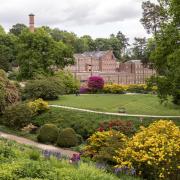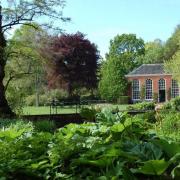Medieval streets, a hotel with its own vineyard, violet marshmallows...Martin Pilkington samples the delights of South-West France
Some choose to holiday in the same safe spot every year, others travel to discover new things. It’s the same with eating out – the simple steak or something more adventurous. A trip to the Midi-Pyrenees region of South-west France happily combines both philosophies.
This is an area rich in ancient sites and jealous of its culinary traditions: foie gras, magret de canard, Lautrec’s pink garlic, and Roquefort cheese. But over recent years it has attracted chefs keen to push the boundaries, six of them with a Michelin star the focus of our tour.
Our gastronomic expedition began well at L’Esprit du Vin in Albi, yards from the 13th century cathedral whose intricately painted interior provides its own contrast with dour brick-fortress walls. Chef David Enjalran’s style blends the traditional – pigeon from Mont Royal, and brandade (salt cod worked into potato) – with the innovative like apple liqueur granita topped with liquorice ice cream. Flawless and fun.
The evening’s outing at the Bistrot des Saveurs in Castres run by Geordie chef Simon Scott proved equally rewarding. Again a sense of fun shone through dishes that bookended the meal, a foie gras lolly nibble and his ironic tip of the toque to Britain’s past, ‘Black Forest Gateau Revisited’, a far cry from the 1970s Berni Inn version.
Back in Albi our hotel, La Réserve, overlooked the River Tarn, a huge picture window in the breakfast room framing the scenery. At the city’s heart the Toulouse-Lautrec Museum is housed in the Episcopal palace which after years of refurbishment reopened in 2012. This is the world’s largest collection of the artist’s works and artefacts, a fitting homage to Albi’s most famous son, its setting at once medieval and modern. Neighbouring Castres rivals it with France’s largest collection of Spanish art in the Goya Museum, again once a bishop’s palace.
The foodie winning streak continued at La Falaise in Cahuzac-sur-Vère. In fact in terms of (successful) experimentation it peaked with Guillaume Salvan’s cooking, a solidified cube of goats’ milkshake with wild spinach, peas and mint oil the highlight – clever, fresh, light, delicious.
We exchanged the crisp comfort of La Réserve for the 15th-century magnificence of the Chateau de Salettes, a superb hotel sited in its own vineyard, very modern suite reached by a stone spiral stairway. Contrasts don’t always work: but the car crash of foie gras with sweet raspberry sauce was balanced here by a complex pudding whose disparate elements – mango, coconut, violet marshmallow and toffee-filo – both stood out and blended in.
Third and last hotel was Le Moulin de Cambelong in Conques, where the river’s passage around and beneath the converted watermill provides a soothing natural background to sleep. Chef-proprietor Hervé Busset says: “I began with traditional cuisine, then became interested in wild herbs in my cooking. I buy vegetables at local markets like Decazeville, but have my own market in nature.” His travels in Asia also show in items like a lovely Madelaine with rosemary and Japanese tea, and the best dish of the meal, rocket sorbet with sake. But with a world of flavours to choose from why pick lifeless clover in ice-cream?
Conques itself is a fabulous survival, a carefully preserved medieval town clustered on a hillside around its abbey. Not an aerial in site, nor a plastic window. And the preservation carries through to the church’s treasury, its gold reliquaries and bejewelled crosses hidden during the revolution.
The previous day we visited Cordes sur Ciel, a bastide town equally well kept, just two narrow streets confined within thick stone walls. A museum of a decidedly different sort here, dedicated to the art of confectionery – including artworks created in sugar. Much though sweeties appeal, there is something strange about the craft of replicating life in sugar, chef patissier Teddy Cadars with infinite patience creating a rosebud as we watch.
Save the best for last. On a morning trip to the market in Rodez we discover Aligot, a classic regional filler-upper made with smooth mashed potato into which melted Tomme cheese and crushed garlic is incorporated. Its simplicity is worlds away from much of the cooking thus far. We are delighted then when Michel Truchon at Le Sénéchal in Sauveterre de Rouergue serves this with a pink saddle of lamb. Other items on his menu incline towards cuisine bourgeoise – duck liver with herby duck jus and fruit chutney; a mousse and sorbet of strawberries – but cooked with a master’s hand.
Truchon is not afraid of trickery – witness the foam (modern chefs can’t resist them) of aubergine and oyster atop the lightly pickled sardine served as an amuse bouche. But nor is he afraid to serve the classically simple. In a crowd of creative cooks he stands head and shoulders above the rest, and it is his restaurant in the middle of nowhere – tellingly crowded - that will one day draw this writer back.
Martin travelled courtesy of Atout France:
www.tourism-midi-pyrenees.co.uk; www.tourisme-aveyron.com; www.tourisme-tarn.com
Hotels:La Réserve Albi double room from €248 to suite €498
Breakfast €20 Menus from €49 http://www.lareservealbi.com
Chateau de Salettes Menus €29, €39, €55, €80
Rooms €135 standard room in low season to suite €370 high season
Breakfast €20 www.chateaudesalettes.com
Hotel Hervé Busset/Le Moulin de Cambelong rooms from €110 - €180 at rear, to a junior Suite at €350 - €400
Breakfast €20 Menus from €39 www.moulindecambelong.com



























